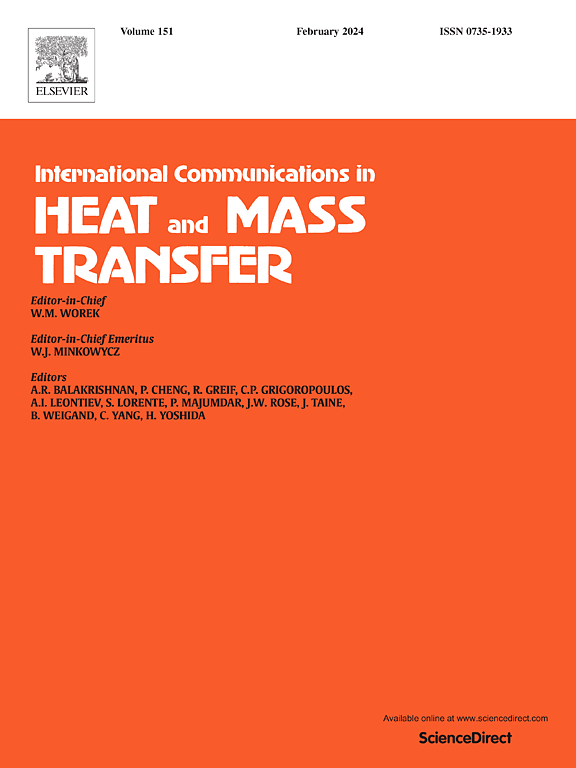Harnessing solar energy with phase change materials: A review of melting point impacts
IF 6.4
2区 工程技术
Q1 MECHANICS
International Communications in Heat and Mass Transfer
Pub Date : 2025-05-21
DOI:10.1016/j.icheatmasstransfer.2025.109094
引用次数: 0
Abstract
Phase Change Materials (PCMs) offer significant potential to enhance the efficiency and reliability of solar energy systems by mitigating energy supply intermittency. This review explores the classification, properties, and integration of PCMs into solar technologies, including solar thermal collectors, photovoltaic (PV) systems, and concentrated solar power (CSP) systems. PCMs store and release thermal energy via phase transitions, with key thermophysical properties—such as high latent heat of fusion, thermal conductivity, and phase stability—being vital for improving energy storage and system performance. PCMs are classified into organic, inorganic, and eutectic types, each with distinct advantages and limitations. Organic PCMs (e.g., paraffins) are chemically stable and non-corrosive but have low thermal conductivity. Inorganic PCMs (e.g., salt hydrates) offer higher conductivity and storage capacity but face challenges like phase segregation and corrosion. Eutectic PCMs combine organic and inorganic elements, offering tunable melting points and enhanced thermal properties. The review highlights novel integration methods—encapsulation, impregnation, and nanoparticle incorporation—to improve PCM performance. Economic considerations, including cost-effective materials and sustainable manufacturing, are discussed. Emerging developments, such as composite PCMs and nanomaterials, are identified as key areas for future research, underscoring PCMs' role in advancing solar energy storage and supporting a sustainable energy future.
利用相变材料利用太阳能:熔点影响的综述
相变材料(PCMs)通过减少能源供应的间歇性,为提高太阳能系统的效率和可靠性提供了巨大的潜力。本文综述了pcm的分类、特性及其在太阳能技术中的应用,包括太阳能集热器、光伏(PV)系统和聚光太阳能(CSP)系统。pcm通过相变存储和释放热能,其关键的热物理特性——如高融合潜热、导热性和相稳定性——对提高能量存储和系统性能至关重要。PCMs分为有机、无机和共晶三种类型,每种类型都有其独特的优点和局限性。有机pcm(如石蜡)具有化学稳定性和无腐蚀性,但导热性低。无机pcm(如盐水合物)具有更高的导电性和存储容量,但面临相偏析和腐蚀等挑战。共晶pcm结合有机和无机元素,提供可调的熔点和增强的热性能。这篇综述强调了新的集成方法——包封、浸渍和纳米颗粒掺入——以提高PCM的性能。经济方面的考虑,包括具有成本效益的材料和可持续制造,进行了讨论。新兴的发展,如复合pcm和纳米材料,被确定为未来研究的关键领域,强调了pcm在推进太阳能储能和支持可持续能源未来方面的作用。
本文章由计算机程序翻译,如有差异,请以英文原文为准。
求助全文
约1分钟内获得全文
求助全文
来源期刊
CiteScore
11.00
自引率
10.00%
发文量
648
审稿时长
32 days
期刊介绍:
International Communications in Heat and Mass Transfer serves as a world forum for the rapid dissemination of new ideas, new measurement techniques, preliminary findings of ongoing investigations, discussions, and criticisms in the field of heat and mass transfer. Two types of manuscript will be considered for publication: communications (short reports of new work or discussions of work which has already been published) and summaries (abstracts of reports, theses or manuscripts which are too long for publication in full). Together with its companion publication, International Journal of Heat and Mass Transfer, with which it shares the same Board of Editors, this journal is read by research workers and engineers throughout the world.

 求助内容:
求助内容: 应助结果提醒方式:
应助结果提醒方式:


